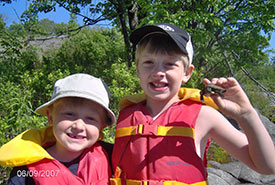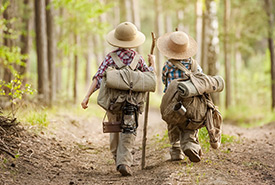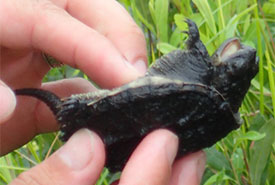Saving wonder

One of my most treasured photos of my kids discovering a turtle when they were little (Photo by Dan Kraus/NCC staff)
“I caught a turtle!” The call rang out repeatedly over the lake near Algonquin Park, where my family has a cottage. It was early, my teenage boys were still in bed, when the turtle-catching alarm came. It was from across the lake, in a large cottage that I knew was often rented. As I sat with a coffee on our dock, I watched the distant scene unfold.
Two kids, maybe about eight or 10 years old, were standing around a bucket. One was bent over and appeared to be frozen, the other couldn’t stop moving. She was the voice of discovery. Within a minute, other young kids ran from the cottage to the edge of the lake, followed, slowly, by parents. A half-hour of pointing, screaming and laughter ensued before the turtle was released and they trickled back into the cottage. Finding a turtle is a great way to start any day.
As I scientist, I like measuring and reporting on nature and the impact of investments we make at the Nature Conservancy of Canada (NCC). Numbers of rare species, or reporting to Environment and Climate Change Canada on the impact of our Natural Areas Conservation Program are part of my job. These are important measures of our success. I want future generations to have the same species and landscapes that are part of my Canada. But although we can’t measure it, it seems that one of the most important legacies we leave behind when we protect nature is this: the opportunity for finding wonder.
Discovery and the unexpected have always been part of the human experience. But in our technological world it’s becoming harder to find genuine wonder. My smartphone amazes me, but I know someone engineered it and knows how it works. A movie might astonish me, but it’s an experience designed to astonish a million other people. Contrived surprise in the marketplace is not the same as the unexpected and unique experiences in nature that await us all.

Kids trekking through forest (Photo by Shutterstock)
Adults are the gatekeepers to wonder ― a role we must embrace. Our job is perhaps harder now than it has ever been. In a world where we are all increasingly separated from nature, it is our responsibility to provide the setting and to create the opportunity for discovery. Children are all wired for wonder. We can make the connections by giving them every opportunity possible to be outside in nature. You don’t need to be a naturalist or biologist. You don’t have to have a program or plan or park pass. Unlocking wonder is a simple as spending time in nature.
Moments of discovery and wonder are one of the gifts we must pass on to kids. The intensity of discovery fades, but it leaves a lasting mark in the character of a child. It can clear the path for a lifetime of curiosity, a desire for learning, and open the heart to compassion for our natural world. An absence of wonder can leave a wall of apathy, selfishness and neglect.

Juvenile snapping turtle (Photo by NCC)
Witnessing that moment of wonder at our cottage triggered my earliest turtle memory. It was a small snapping turtle I had caught with another kid, named Kenny, in a pond near Baden, Ontario, where I went to public school. An empty net went into the pond, a net with a turtle came back out. That image will be with me forever. I was a lucky kid ― I was given time in nature to make discovery, and to connect with our natural world.
I don’t know what kind of turtle those kids across the lake from our cottage caught, but it was probably a painted turtle or snapping. It doesn’t matter. Maybe one day one of those kids will want to know. More importantly, I hope that they will all want their own children to experience turtles and to protect nature. I hope they want to save wonder.


